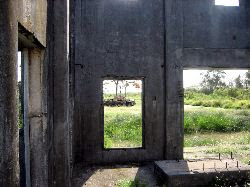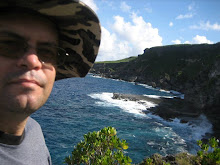 Isley Field is one of the most complete WWII airports surviving today. This airport was originally called As Lito Field during the Japanese occupation and was among the first objectives for the U.S. Marines landing on Invasion Beach a mile to the west. Construction to repair the airfield began immediately with fierce fighting on all sides of the runway. The American soldiers used the existing buildings for the same purpose as the Japanese soldiers did the day before. 24 hour-a-day construction continued throughout the Battle of Saipan to add a second runway and increase the length of the runways to accommodate the American B-29 bombers.
Isley Field is one of the most complete WWII airports surviving today. This airport was originally called As Lito Field during the Japanese occupation and was among the first objectives for the U.S. Marines landing on Invasion Beach a mile to the west. Construction to repair the airfield began immediately with fierce fighting on all sides of the runway. The American soldiers used the existing buildings for the same purpose as the Japanese soldiers did the day before. 24 hour-a-day construction continued throughout the Battle of Saipan to add a second runway and increase the length of the runways to accommodate the American B-29 bombers.
One night, 500 heavily armed Japanese soldiers snuck through the front line at Nafutan Peninsula and blew up many parked American planes at Isley Field. The Japanese soldiers then withdrew to Mt. Nafutan where they stumbled upon a sleeping American field artillery unit. None of the 500 Japanese soldiers survived that encounter.
Isley Field not only helped in ending the Battle of Saipan but WWII as well. By 1945 an American military city grew from Isley Field to the Obyan Beach area. Tens of thousands of American soldiers lived there working in shifts around-the-clock loading B-29's for the constant bombing of Japan. Today the city is gone, swallowed by the jungle. Many of the roads are nothing more than hiking trails leading to cement foundations, the only remaining evidence of the city.
1945 aerial picture of the city from Isley Field to Obyan.
 After the capture of As Lito Field the airport was briefly renamed Conroy Field and then renamed again to Isley Field in honor of the first American pilot to loose his life in the Battle of Saipan. He was shot down near the end of the runway. Its name changed a couple more times after WWII and is currently called the Saipan International Airport which is still used today.
After the capture of As Lito Field the airport was briefly renamed Conroy Field and then renamed again to Isley Field in honor of the first American pilot to loose his life in the Battle of Saipan. He was shot down near the end of the runway. Its name changed a couple more times after WWII and is currently called the Saipan International Airport which is still used today.
Japanese WWII air raid shelter (bottom left) right next to the modern tower.
One of 120 B-29 hardstands.





The Japanese As Lito Field power plant.






This bunker was originally Japanese. The 2,000 pound bombs used for the Japanese attack on Guam were stored here. After the Battle of Saipan, American bombs were stored here for the attack on Japan.

The original camouflage is still visible.

Notice the track on the roof used to move the bombs in and out of the bunker.

Several of these Japanese bunkers survived the battle and were put to use by the American military. Notice the 1944 sign painted on the side: "ISLEY FIELD BASE COMMAND" and below that possibly added after WWII: "TYPHOON SHELTER". Today these bunkers are still being used as government offices.










The Japanese As Lito Field power plant.






This bunker was originally Japanese. The 2,000 pound bombs used for the Japanese attack on Guam were stored here. After the Battle of Saipan, American bombs were stored here for the attack on Japan.

The original camouflage is still visible.

Notice the track on the roof used to move the bombs in and out of the bunker.

Several of these Japanese bunkers survived the battle and were put to use by the American military. Notice the 1944 sign painted on the side: "ISLEY FIELD BASE COMMAND" and below that possibly added after WWII: "TYPHOON SHELTER". Today these bunkers are still being used as government offices.






















































11 comments:
I love this place....
me ha gustado mucho tu blog
el mio es
www.festeroilicitano.blogspot.com
saludos desde España
This is so fascinating Eric! And thank you for your great photos and the info to go with them! It is hard to understand the complexities of war. And that ariel view taken in 1945. A city simply all but vanishes. Thank you for sharing all of this!
Thank you Eric for your information about Isley Field and the island as a whole. My father (Elmer Thurmer) was posted there working on fighter aircraft for the Navy. He talked about building a home made radio and hearing about Hiroshima being bombed with the atomic bomb. He also built a electric steam engine while stationed on the island. It was made from a 105 mm shell and the whistle was from a bullet he found. It now is a museum at Jackson, Minnesota and still works. He talked about Suicide Cliff and how horrible it was and how he was almost shot by a sniper once while at the base. I have always wanted to see the island, but alas with a teacher's salary, it was impossible. Thank you for taking the time to film the island, I felt while watching the videos that I shared some of my dads thoughts while he was there as well. Once again, thank you and God Bless! August Thurmer
Thank you August. I'm glad to have the opportunity to document what still remains of WWII in Saipan. And thanks to your father and so many others like him. We are still benefiting from all their efforts and sacrifices.
Think of all the carnage that took place... All very young men.
Eric, your passion for this island is so obvious and we are all so very fortunate to have discovered you to read up on the history of the island and view the vivid photos that you post. Please don't stop the fantastic work!!!
Daniel
Thanks Daniel. I am very glad you like it. I will continue to add more pictures, videos, and information to the pages on this site.
My father, Lieutenant K M Cushman, flew TBFs off the USS Lexington (CV-16), striking Saipan and at the Battle of the Philippine Sea, where he was in the "Mission Beyond Darkness."
On a strike on Aslito Field, he saw his squadron commander, Bob Isely, shot down over the airfield with the loss of the plane and the three-man crew. The TBFs were using rockets, much to the dismay and disgust of the fliers, as they didn't trust the effectiveness of the weapons and didn't like the way the aircraft had to approach the target to get the job doe. Isely did not release on his first or second pass over his target. On the third pass, the Japanese AA, thoroughly alerted, hit him and, as my father said, swatted him down. One source said he was lost strafing. This is unlikely. The TBF (and TBM) had only two forward-firing .50 caliber Brownings and the airplane was not a good strafing plane. Most likely, Isely was following a technique where the pilot used the .50 caliber tracers to hit a target wherein the rockets were pickled off and, theoretically, followed the same path as the bullets to hit the designated target. I have a photo album with pre-deployment snaps of a VT-16 get-together which includes photos of Isely which I plan to donate to the USS Lexington in Corpus Christi.
During WWII, my Dad was first assigned to 8th AAF in Bassingbourne England, as a radio operator on the B-17 'Jack the Ripper'. After 11 assignments, he and crew came back to the US and were assigned to write the manual for future crews flying B-17s in Europe. After that, my Dad went to OCS school in FL, became a Lieutenant and from there was in training in Salina, KS and eventually sent to Saipan. I have loads of information about his tour in Europe, but he never talked about nor do I have much information about his Pacific tour in Saipan, except for some photos he sent my Mom that are still in a scrapbook! So, the last few years I've been doing a lot of research on that part of his WWII participation. I've come up with lots of information I've found on the internet and came across your web blog. I'd love to visit Saipan to try and get some perspective on his time there, hopefully that will happen in the near future. Thanks for your interest, photos and information~~it has peek my interest even more to travel to Saipan. Thanks Pat
My fatherinlaw was aircrew for 318th there. They gad a rare land battle at night ti save the base.
Post a Comment